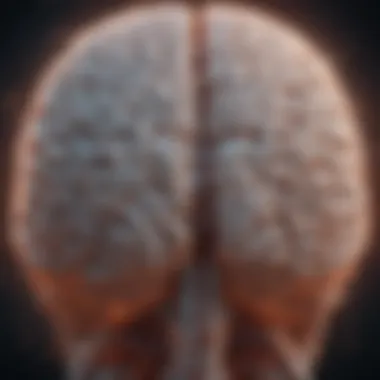Calming the Anxious Brain: Mindfulness Techniques


Intro
In today’s fast-paced world, anxiety often lurks in the shadows, waiting to pounce when least one expects it. Amidst the whirlwind of responsibilities and expectations, one may find solace in understanding not just what anxiety is, but how it affects the brain. This article embarks on a journey through the intricate relationship between anxiety and brain function, leading us toward mindfulness as a beacon of hope.
At its core, mindfulness represents a way of being—an immersive experience in which one fully engages with the present moment without judgment. The art of mindfulness is not merely a trendy buzzword; instead, it’s an age-old practice that offers tangible benefits for navigating the tumultuous waters of anxiety. By the end of this piece, readers will be equipped with insights that bridge scientific research with practical applications, providing tools for enhancing mental well-being and fostering a state of tranquility.
Understanding Anxiety and Its Impact
Anxiety is more than just feeling nervous or worried. It’s a complex emotional state that can significantly affect one’s mental and physical well-being. In understanding anxiety and its impact, one sees how deeply this issue permeates everyday life, affecting decision-making, relationships, and quality of life. Providing a comprehensive analysis of anxiety lays the groundwork for effective mindfulness practices.
When individuals understand anxiety better, they gain insight into their emotions and physiological reactions. This understanding plays a crucial role in self-regulation. It helps in recognizing patterns that perpetuate feelings of unease or dread. Without this awareness, dealing with anxiety can feel like trying to navigate a storm without a compass.
Understanding anxiety is empowering; it transforms anxiety from an abstract fear into a manageable concept. Knowledge about the triggers of anxiety and its effects on the body fosters resilience. As awareness increases, individuals can make informed choices regarding strategies that resonate with them. This does not mean expecting to eliminate anxiety completely, but rather learning how to coexist with it.
"Understanding your anxiety is like shining a light into the shadows; suddenly, what was intimidating becomes clearer."
Defining Anxiety
Anxiety, in simple terms, is a feeling of fear or apprehension about what’s to come. It's a natural response to perceived threats; however, when the feelings become overwhelming or persistent, anxiety can lead to various disorders. Generalized Anxiety Disorder, Panic Disorder, and Social Anxiety Disorder are some examples of how this feeling can manifest. Key to defining anxiety is recognizing that it is not always a bad thing—it can help individuals prepare for challenges.
As common as it is, anxiety can strike at any time and often feels like a wave crashing down unexpectedly, leaving one gasping for breath. It's essential to pinpoint the distinction between anxiety as a temporary state and a more chronic condition that disrupts daily life.
The Brain's Response to Anxiety
Neurotransmitters and Anxiety
Neurotransmitters are like the body’s messengers, handling a variety of processes. In the context of anxiety, several neurotransmitters, such as serotonin, dopamine, and norepinephrine come into play. These chemicals can impact mood regulation and how the body responds to stress.
For example, serotonin often gets the spotlight in discussions about mood stabilization. Low levels can contribute to anxiety, making this neurotransmitter a significant player in mental health discussions. It highlights the connection between brain chemistry and emotional states. When one understands how these neurotransmitters operate, it allows for better-targeted strategies. For those grappling with anxiety, the potential advantages of modifying neurotransmitter activity through therapy or medication may offer pathways to relief.
The Amygdala's Role
The amygdala is an almond-shaped set of neurons located deep in the brain that play a pivotal role in processing emotions. In anxious individuals, this area can become hyperactive, leading to heightened responses to perceived threats. The amygdala's function highlights why some seem to react disproportionately to stressors.
It acts as an alarm system, amplifying sensations of fear and anxiety when it misinterprets harmless situations as dangerous. Understanding its role can empower individuals to work on techniques that dampen these instinctual reactions, thereby reducing anxiety levels. By learning to calm the amygdala, a person may effectively take the wheel when anxiety surges.
Impact on Cognitive Function
Anxiety doesn't only stir emotional waters; it also muddles thought processes. When caught in the grip of anxiety, cognitive functions like memory, decision-making, and concentration can suffer. It's like trying to tune into a radio station while overlapping signals create static; clear thought becomes a challenge.
The key characteristic here is the brain’s decreased ability to filter out distractions, which can impair judgment and problem-solving skills. This understanding helps many to recognize that the mental fog they experience under anxiety isn't a personal failing, but rather a biological incline. Even as they face daily interactions or challenges, becoming aware of how anxiety can disrupt their cognitive capabilities is the first step toward re-establishing control.
The Science of Stress and the Anxious Brain
Understanding the intricate relationship between stress and anxiety is crucial in addressing mental well-being. Stress can act as a double-edged sword, affecting both psychological and physical health. By examining the underlying science, we can better grasp how anxiety manifests and how mindfulness techniques can facilitate a path to relief. This section will spotlight various aspects—stress responses, physiological changes, and chronic stress—that lay the groundwork for developing effective coping strategies.
Understanding Stress Responses
When the body perceives a threat, it activates a complex stress response system. This is not just a biological reflex; it’s an essential survival mechanism. It involves the release of hormones, such as adrenaline and cortisol, which helps prepare the body to face challenges or escape danger. This is often referred to as the fight or flight response.
In modern contexts, however, stressors are often more psychological than physical. Everyday pressures—be it work deadlines, relationship troubles, or financial concerns—can trigger the same physical responses. This can lead individuals to unknowingly remain in a chronic state of stress. It's important to become aware of these responses to effectively manage anxiety and stress levels.
Physiological Changes in Anxiety
The human body is a marvel of adaptation, responding to stress in several ways:
Cortisol and Its Effects
Cortisol is often called the stress hormone. Its primary role is to manage how your body uses carbohydrates, fats, and proteins, and it plays a central role in responding to stress.
While a short burst of cortisol can be beneficial during emergencies, long-term exposure can lead to health issues such as high blood pressure, disrupted sleep, and impaired cognitive function. This article highlights the importance of monitoring cortisol levels, as elevated levels persistently can exacerbate anxiety symptoms.
Moreover, the unique aspect of cortisol is its ability to influence memory and learning processes. Chronic elevation can disrupt these cognitive functions, making it challenging for individuals to focus and think clearly. That’s why integrating stress-reducing techniques is vital for rebalancing cortisol levels
The Fight or Flight Response
The fight or flight response is an evolutionary adaptation providing a crucial survival advantage. This reflex rapidly prepares the body for quick action. While it served humanity well in the face of actual danger, in modern life, it can trigger responses over minor stressors, leading to anxiety.


A key characteristic of this response is the way it causes the body to prioritize functions, like increasing heart rate and redirecting blood flow to essential muscle groups.
However, the unique feature of an exaggerated fight or flight response in reaction to stressors can cause detrimental effects on overall mental health. Constantly being in this state can lead to burnout and chronic anxiety. Acknowledging this physiological mechanism allows us to recognize when we’re stuck in a loop of anxiety and to initiate mindful practices that ground us.
Long-term Consequences of Chronic Stress
Chronic stress doesn’t just wear you down mentally; it also takes a toll on physical health. With prolonged exposure to stressors, the body's normal coping mechanisms can become burdened.
The key characteristic of long-term stress is its ability to exacerbate issues like heart disease, diabetes, and weakened immune function. It's significant because a person might not initially notice these effects.
Unique to chronic stress is how it can influence emotional health, leading to issues such as depression and ongoing anxiety. It’s imperative that this be recognized to mitigate potential damage and address underlying anxiety issues.
Long-term stress and anxiety create a self-replicating cycle; recognizing this pattern is the first step towards mental peace.
In summary, understanding the biological responses to stress is fundamental in dealing with anxiety. By shedding light on cortisol's roles, the fight or flight mechanism, and the consequences of chronic stress, we can better appreciate how mindfulness techniques may foster resilience against anxiety. This lays the foundation for exploring practical strategies in the following sections.
Mindfulness as a Tool for Anxiety Relief
In our fast-paced world, the term mindfulness has cropped up time and again, often associated with tranquility and self-improvement. But what does mindfulness genuinely entail, and how does it serve as a tool for easing anxiety? At its core, mindfulness is about being present, really tuning in to the here and now. It involves paying attention to our thoughts, emotions, and bodily sensations without judgment. This attention can be a powerful antidote to anxious feelings that tend to spiral out of control when we’re lost in worrying about the past or future.
Engaging with mindfulness practices can help individuals cultivate a greater understanding of their anxiety, recognizing it as a natural response rather than something to be feared. One begins to observe anxious thoughts as mere passing clouds in the sky rather than the whole storm. Benefits tied to mindfulness include enhanced emotional regulation, reduced stress levels, and improved overall mental health.
However, it's crucial to consider that embracing mindfulness isn't a one-size-fits-all solution. Each individual’s experience with anxiety is unique, necessitating a personalized approach to mindfulness practices. Some may find solace in meditation, while others may prefer yoga or simply spending time in nature, fully aware of their surroundings.
"Mindfulness offers a pathway out of the tumult of the mind, a chance to anchor oneself in the moment and step back from the frenzy of anxious thoughts."
Additionally, establishing a mindfulness practice requires consistency and patience. Whether it takes 5 minutes or an hour, the commitment to engage in mindfulness regularly can yield significant benefits over time. It's this gradual transformation that underscores why mindfulness is regarded as an essential tool in the toolbox of anxiety relief.
Conceptualizing Mindfulness
Mindfulness might sound simple, but it’s an intricate practice that combines focus, awareness, and acceptance. The process starts by simply being conscious of your breath. Take a moment to notice your inhalations and exhalations. This act, while seemingly trivial, creates a bridge to deeper self-awareness. Mindfulness promotes a kinder perspective, allowing space to explore feelings without getting tangled up in them.
One vivid analogy is that of a river: mindfulness allows us to observe the flow of our thoughts and feelings as if they are floating by on the water, rather than being dragged under by them.
Regular practice can cultivate a deep-rooted habit of approaching anxiety with curiosity instead of fear. It allows for the recognition of triggers and responses, thereby fostering a more equipped mindset to tackle what life throws at us.
Research Evidence Supporting Mindfulness
Research backs up the claims that mindfulness can help reduce anxiety significantly, with various studies shedding light on its profound impact.
Clinical Studies and Findings
Numerous clinical trials have examined mindfulness-based interventions and their effects on anxiety levels. These studies often indicate that participants experience noticeable declines in their anxiety symptoms after engaging in structured mindfulness programs.
A particularly compelling feature of these studies is the systematic approach they often follow, measuring several outcomes like emotional regulation, stress levels, and overall mood. This rigorous methodology lends weight to the findings, establishing a clear correspondence between mindfulness training and reduced anxiety.
Additionally, these studies reveal that mindfulness practices help improve cognitive flexibility, allowing individuals to shift their perspective and engage better in problem-solving. Such a cognitive shift makes mindfulness a beneficial choice when addressing anxiety disorders, ensuring that individuals are not merely managing symptoms but actively rewriting their relationship with anxiety.
Neuroplasticity and Mindfulness Training
One striking aspect of engaging in mindfulness exercises is the concept of neuroplasticity—the brain's ability to reorganize itself by forming new connections. Studies show that mindfulness training can indeed engender neural changes in areas responsible for emotion regulation and stress response.
As participants immerse themselves in mindfulness over time, they may observe a tangible alteration in their brain structure and functioning. This characteristic makes mindfulness not just a temporary fix but a profound approach with potential long-term benefits for mental health.
Moreover, mindfulness affects the amygdala, which plays a pivotal role in processing emotions. Reduced activation in this area can lead to a calmer mindset, lower anxiety responses, and healthier coping mechanisms when facing stressors.
Ultimately, the contributions of neuroplasticity underscore the adaptiveness of our brains when we consistently engage in mindfulness. While the immediate results can be encouraging, the long-term changes paint an even more hopeful picture. As individuals harness mindfulness, they equip themselves with tools that can genuinely alter their brain’s wiring towards a more peaceful existence.
Practical Techniques for Calming the Anxious Brain
In today’s fast-paced world, the tendency for anxiety seems to have become a common thread in the fabric of daily life. Practical techniques aimed at calming the anxious brain serve as essential tools for managing stress. By integrating these techniques into daily routines, individuals can foster mental well-being. It’s about creating a comprehensive strategy that incorporates manageable steps to cultivate a sense of calm amidst the chaos.
Deep Breathing Exercises
Deep breathing exercises, or controlled breathing, present a straightforward yet powerful approach to reducing anxiety. One of the essential benefits of these exercises is their immediate impact on the body’s physiological response to stress. By consciously focusing on breath, individuals can activate the body’s relaxation response, often helping to mitigate feelings of unease quickly.
Diaphragmatic Breathing
Delving into diaphragmatic breathing, this technique involves engaging the diaphragm as one inhales, allowing for deeper and more efficient breaths. When you breathe in deeply through the nose, filling the abdomen rather than the chest, you are tapping into a primal response of calm.


The key characteristic of diaphragmatic breathing lies in its ability to slow the heart rate and lower blood pressure, creating a physiological state that encourages relaxation. It’s a beneficial choice for those managing anxiety because it’s easy to practice anytime—whether you’re stuck in traffic or navigating life’s unpredictability.
One unique feature of this method is its accessibility; anyone can do it without the need for tools or special settings. However, it can take someone's awareness to learn, as many are used to shallow chest breathing.
Box Breathing Technique
The Box Breathing Technique is another fantastic method to combat anxious feelings. This structured breathing pattern involves inhaling for a count of four, holding for four, exhaling for four, and pausing for another four. This cyclical approach provides a clear focus, drawing attention away from stressors and directing it toward the rhythm of breathing.
Its pivotal characteristic is the equal duration of each phase, which creates a balanced practice. This predictability can be particularly calming when in a heightened state of anxiety, making it a popular tool in various settings, including military and emergency services.
The unique feature of box breathing is its simplicity and adaptability; you can integrate it into any situation. The disadvantage, however, is that beginners might initially find counting while breathing to be a distraction rather than a relief. Yet, with practice, it becomes a steady anchor in turbulent waters.
Guided Visualization
Guided visualization extends the mind's reach by creating a mental safe haven. It's a technique that encourages individuals to imagine peaceful settings, invoking sensory experiences that promote tranquility. The remarkable aspect of guided visualization is its flexibility; you can tailor it to your preferences or mental state, making it a personalized refuge against anxiety.
Creating a Safe Space
Creating a safe space in one's mind involves envisioning a calming environment where worries fade. This practice helps individuals detach from real-world stressors, granting them the freedom to experience peace even when facing external chaos. The key advantage is the sense of empowerment it provides—being in control of one’s mental landscape can significantly bolster confidence and resilience against anxiety.
A unique feature is its reliance on anticipation; the more one practices, the easier it becomes to access that mental sanctuary. However, for some, imagining such spaces may initially feel challenging, as the mind clings to anxious thoughts. Regular practice can ease this transition, making it more accessible over time.
Imagery Techniques
Imagery techniques expand the creative scope of one's mind. This practice encourages deep connection with emotions through vivid imagery, facilitating emotional release and healing. The key element here is the evocative power of imagery that allows deeper exploration of feelings tied to anxiety, often leading to catharsis.
These techniques are immensely beneficial due to their versatility—you can focus on positive memories, serene landscapes, or even abstract concepts related to calmness. However, success largely hinges on one's comfort with visualization; not everyone finds it easy to create detailed mental images. Some may prefer physical techniques but can learn to integrate imagery over time with patience and persistence.
Body Scan Meditation
Finally, body scan meditation draws attention to sensations throughout the body, promoting awareness and acceptance. This practice involves mentally scanning your body from head to toe, observing areas of tension and consciously releasing it. The beauty of body scan meditation is its holistic approach—it not only addresses the mind but also connects with the physical self.
This practice encourages individuals to cultivate an intimate relationship with their bodies, recognizing manifestations of anxiety that might otherwise go unnoticed. By developing body awareness, individuals can learn to identify stress before it escalates. However, some might find it uncomfortable at first, especially if they’re not used to focusing internally in a stillness.
In sum, the outlined practical techniques offer a multi-faceted toolkit for those on the path to calming the anxious brain. Each approach has distinct characteristics and advantages, complementing the overarching journey toward mindfulness and peace.
Cultivating a Mindful Habit
Cultivating a mindful habit is an essential process in the journey towards anxiety relief. The intricacies of daily life can wear on our minds, creating a mental clutter that exacerbates anxiety. By establishing a routine and creating an environment that nurtures mindfulness, individuals can foster a sense of calm and stability. The benefits are far-reaching, including improved emotional balance, reduced stress levels, and enhanced overall well-being.
Establishing a Routine
Consistency in Practice
When it comes to establishing a mindfulness routine, consistency is key. Practicing mindfulness regularly can help it become ingrained in daily life, transforming mere moments into opportunities for serenity. After all, like they say, practice makes perfect. One of the standout features of consistency is its ability to create lasting change. A routine fosters an environment where individuals can tap into mindfulness without the pressure of setting aside time for it specifically.
Through consistent practice, users can carve out just a few minutes a day, perhaps in the morning with a few deep breaths or in the evening with some light meditation. The real beauty here is that this approach doesn’t demand much but offers substantial returns. However, a potential downside is the risk of monotony. Switching things up or introducing different techniques can alleviate this worry and sustain interest in the practice.
Creating a Mindful Environment
Having a space dedicated to mindfulness can significantly enhance the practice. Creating a mindful environment involves transforming physical surroundings into sanctuaries of tranquility. It’s about setting up a cozy corner in one’s home or arranging a small area in a garden—all tailored to bring peace of mind. This environment serves as a cue for the brain, signaling that it’s a moment of calm amidst the chaos of everyday life.
A tranquil setting possesses the character of simplicity and minimalism. Clear surfaces, calming colors, and perhaps a plant thrown in can help reinforce this. The unique aspect of this approach is that, in addition to physical changes, sensory elements—like soft lighting or gentle sounds—can be integrated. One potential drawback, though, is that not everyone might have the luxury of a dedicated space, but even a small rearrangement or a few minutes spent in nature can provide similar benefits.
Incorporating Mindfulness into Daily Life
Mindful Eating Practices
Mindful eating stands out as a remarkable method of incorporating mindfulness into everyday tasks. By deliberately focusing on the act of eating, individuals can cultivate a deeper sense of connection with their meals, making each bite an experience rather than a hurried activity. This practice contributes positively to emotional regulation and can even foster healthier eating habits.
The key here is intentionality: slowing down, appreciating flavors, and even being aware of thoughts and feelings while eating creates a wholesome experience. One unique feature of mindful eating is its ability to help tackle emotional eating, as individuals become attuned to their actual hunger cues. Yet, some might find it challenging to slow down, especially in a culture that values speed and efficiency; thus, building this habit takes dedication.
Interpersonal Mindfulness
Interpersonal mindfulness focuses on cultivating awareness in interactions with others. By being fully present during conversations and exchanges, individuals can enhance their relationships and nurture a stronger sense of connection. This practice contributes significantly to emotional intelligence, allowing one to empathize and communicate effectively reciprocally.
The character of this approach lies in fostering genuine interactions. One unique feature is the ability to listen deeply rather than just waiting for one's turn to speak. This not only improves communication but also strengthens bonds among family and friends. A potential downside, however, might arise in tense or conflict situations, where maintaining mindfulness can prove to be a challenge. But overcoming these hurdles can yield remarkable benefits, resulting in healthier relations and a more supportive social network.


Practicing mindfulness regularly leads to profound changes in how we respond to life’s challenges.
The Role of Support Systems in Managing Anxiety
Anxiety can feel like a dark cloud hovering over one’s thoughts and actions. That’s where support systems play a vital role. They act as a buffer against the stormy seas of anxious feelings. Whether through friends, family, or professionals, having a network of support can significantly impact how one navigates anxiety. These systems can offer emotional validation, practical assistance, and a sense of belonging. They remind us that we’re not alone in our struggles. In this section, we will explore how professional help, personal relationships, and community resources can all contribute to managing anxiety better.
Seeking Professional Help
When anxiety starts to feel overwhelming, it may be time to seek professional help. This can often lead one on a path toward relief and understanding. There are two main branches here: therapists and counselors.
Therapists and Counselors
Therapists and counselors specialize in interpreting the intricate web of our feelings. They help individuals untangle their thoughts, making sense of the chaos that anxiety can bring. Their training in mental health allows them to employ evidence-based strategies tailored to each individual's needs.
What's notable about these professionals is their adaptability. They offer various therapeutic methods like Cognitive Behavioral Therapy (CBT), which equips people with tools to shift unhelpful thinking patterns. The critical aspect here stems from their expertise, which makes them a popular choice for those grappling with mental turmoil.
A unique feature of therapists and counselors is the confidentiality they maintain. This ensures that individuals can speak freely without fear of judgment. However, there can be drawbacks, such as costs or finding the right fit, which might deter some from seeking help.
Support Groups
Support groups create a community where people share their experiences with anxiety. They allow individuals to connect with others who understand their struggles, cultivating a sense of belonging that many may miss.
The essential aspect of support groups lies in shared experience. Participants often see similar stories reflected back to them, which creates validation. This collective understanding can be tremendously healing.
One of the unique features is the diversity of perspectives people share. It helps individuals discover new coping strategies, broadening their own toolkit for managing anxiety. However, not all support groups are created equal; some may have dominant personalities that can overshadow others, making it harder for all voices to be heard.
Building a Personal Support Network
Building a personal support network is equally important for managing anxiety. Friends and family often serve as the first line of defense. Their presence can make a world of difference when anxiety tries to take the wheel.
Friends and Family Support
Having sturdy relationships in your corner creates a safe haven. Friends and family can provide emotional support and perspective, essential for someone navigating troubled waters. The key characteristic that stands out here is the unconditional love these close ties generally offer. It fosters trust, which is paramount for opening up about anxiety.
The unique feature of such support lies in spontaneity; loved ones can often provide immediate assistance when stressors emerge unexpectedly. But reliance on family or friends can sometimes lead to complications. They may not always know how best to help, potentially leading to misunderstandings or feelings of frustration.
Community Resources
Community resources can provide additional layers of support through programs and initiatives designed for mental health. These services can range from hotlines to workshops focused on mindfulness practices.
The ingenious part of community resources is their accessibility. Many programs offer free or sliding-scale fees, making them an economical choice for those in need. The uniqueness of these resources is their emphasis on collective well-being; they're about building stronger communities focused on mental health.
Yet, some community resources may lack the same depth of personalization found in one-on-one therapy sessions. This can sometimes lead to a one-size-fits-all approach, which might not resonate with every individual.
Emotional support is crucial in managing anxiety. As we navigate this complex battle, it's vital to remember that we don’t have to do it alone.
In summary, the role of support systems in managing anxiety cannot be overstated. Whether through professional help, personal relationships, or community avenues, these networks create a safety net, allowing individuals to explore their emotions while fostering resilience. Establishing a mix of supportive relationships enhances the journey toward mental peace, underscoring the importance of connection in overcoming anxiety.
Moving Towards Mental Peace
Finding mental peace is like searching for a needle in a haystack for those wrestling with anxiety. It’s achievable, but it often feels like pulling teeth. The journey towards tranquility involves understanding what calmness really means for you. It’s not about floating on a cloud but about cultivating a safe space within yourself to navigate life’s storms.
Setting Realistic Goals for Calmness
Setting achievable goals for calmness is key. It’s like trying to climb a mountain; if you don’t set waypoints, you’ll never know how far you’ve come or how far you have to go. Begin by identifying small, specific objectives you can work on over time.
- Break Down Your Goals: Instead of aiming for total calm, try for five minutes of mindful breathing each day. This is tangible.
- Celebrate Small Wins: Acknowledge each tiny success. Did you manage to meditate without distraction today? Give yourself a pat on the back!
- Adjust Expectations: Understand that some days will be easier than others. This isn’t about perfection; it’s about progress.
Evaluating Progress and Adapting Strategies
Assessing where you stand is vital for making the necessary changes. If your current approach to mindfulness isn’t yielding results, it's time to rethink your methods.
Self-assessment Techniques
Self-assessment techniques are powerful for personal growth. They let you take the reins of your journey towards calming the anxious brain. These methods involve reflecting on your feelings, behaviors, and thoughts.
- Keep a Journal: Writing down your experiences provides clarity. You can see patterns you might not notice otherwise.
- Daily Check-ins: Spend a few moments each day asking yourself how you felt and what triggered anxiety. This self-check is an excellent characteristic; it keeps you in tune with your emotions.
- Feedback Loop: Engaging in self-reflection can help adjust your mindfulness practices based on what resonates with your experiences. You know yourself best!
"Self-assessment is like holding up a mirror; it may be uncomfortable at times, but it shows you what needs attention."
Adjusting Mindfulness Practices
Adjusting mindfulness practices when things aren’t working doesn't mean you’re giving up; rather, it indicates that you’re willing to evolve. If a certain technique feels off, explore other options until you find what clicks.
- Experiment with Different Techniques: Don’t box yourself in with just one form of mindfulness; try several like guided meditations, yoga, or tai chi. Variety can make your practice feel fresh.
- Seek Community Input: Sometimes hearing how others address similar challenges can inspire a new approach that might suit you better. You can find such discussions on platforms like reddit.com.
- Be Kind to Yourself: A fundamental part of adjusting is recognizing that it’s okay to stumble. Not every strategy will work for every person, and that’s precisely why a tailored approach is crucial.







